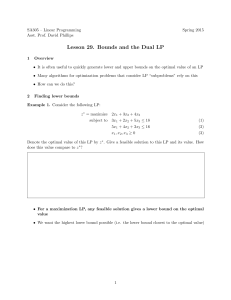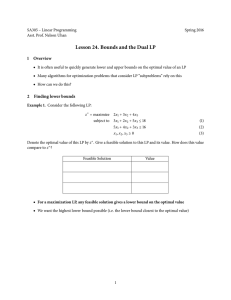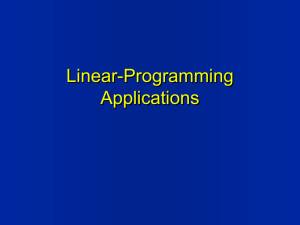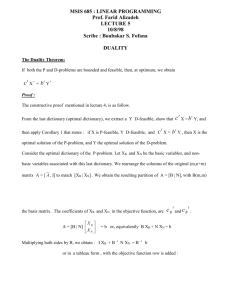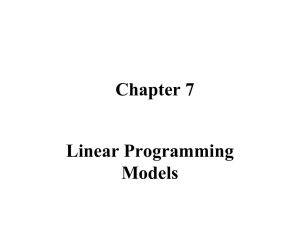Lesson 29. Bounds and the Dual LP
advertisement
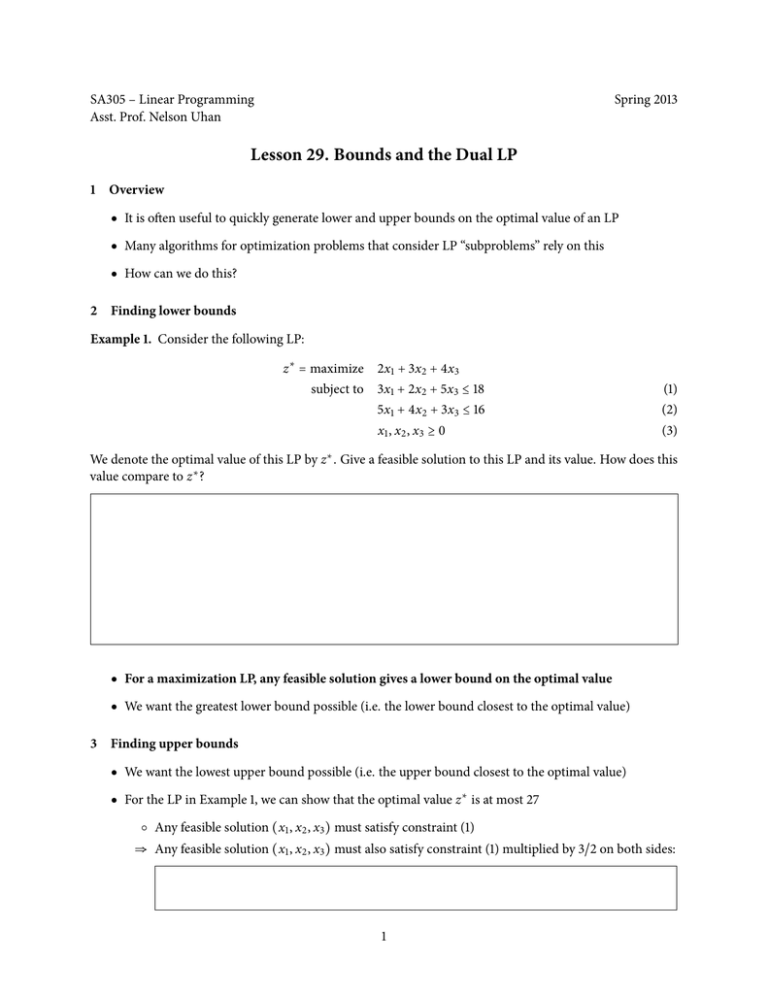
SA305 – Linear Programming Asst. Prof. Nelson Uhan Spring 2013 Lesson 29. Bounds and the Dual LP 1 Overview ● It is often useful to quickly generate lower and upper bounds on the optimal value of an LP ● Many algorithms for optimization problems that consider LP “subproblems” rely on this ● How can we do this? 2 Finding lower bounds Example 1. Consider the following LP: z ∗ = maximize subject to 2x1 + 3x2 + 4x3 3x1 + 2x2 + 5x3 ≤ 18 (1) 5x1 + 4x2 + 3x3 ≤ 16 (2) x1 , x2 , x3 ≥ 0 (3) We denote the optimal value of this LP by z ∗ . Give a feasible solution to this LP and its value. How does this value compare to z ∗ ? ● For a maximization LP, any feasible solution gives a lower bound on the optimal value ● We want the greatest lower bound possible (i.e. the lower bound closest to the optimal value) 3 Finding upper bounds ● We want the lowest upper bound possible (i.e. the upper bound closest to the optimal value) ● For the LP in Example 1, we can show that the optimal value z ∗ is at most 27 ○ Any feasible solution (x1 , x2 , x3 ) must satisfy constraint (1) ⇒ Any feasible solution (x1 , x2 , x3 ) must also satisfy constraint (1) multiplied by 3/2 on both sides: 1 ○ The nonnegativity bounds (3) imply that any feasible solution (x1 , x2 , x3 ) must satisfy ○ Therefore, any feasible solution, including the optimal solution, must have value at most 27 ● We can do better: we can show z ∗ ≤ 25: ○ Any feasible solution (x1 , x2 , x3 ) must satisfy constraints (1) and (2) 1 ⇒ Any feasible solution (x1 , x2 , x3 ) must also satisfy ( × constraint (1)) + constraint (2): 2 ○ The nonnegativity bounds (3) then imply that any feasible solution (x1 , x2 , x3 ) must satisfy Example 2. Combine the constraints (1) and (2) of the LP in Example 1 to find a better upper bound on z ∗ than 25. ● Let’s generalize this process of combining constraints ● Let y1 be the “multiplier” for constraint (1), and let y2 be the “multiplier” for constraint (2) ● We require y1 ≥ 0 and y2 ≥ 0 so that multiplying constraints (1) and (2) by these values keeps the inequalities as “≤” ● We also want: 2 ● Since we want the lowest upper bound, we want: ● Putting this all together, we can find the multipliers that find the best lower upper bound with the following LP! minimize 18y1 + 16y2 subject to 3y1 + 5y2 ≥ 2 2y1 + 4y2 ≥ 3 5y1 + 3y2 ≥ 4 y1 ≥ 0, y2 ≥ 0 ○ This is the dual LP, or simply the dual of the LP in Example 1 ○ The LP in example is referred to as the primal LP or the primal – the original LP 4 In general... ● Every LP has a dual ● For minimization LPs ○ Any feasible solution gives an upper bound on the optimal value ○ One can construct a dual LP to give the greatest lower bound possible ● We can generalize the process we just went through to develop some mechanical rules to construct duals 3 5 Constructing the dual LP 0. Rewrite the primal so all variables are on the LHS and all constants are on the RHS 1. Assign each primal constraint a corresponding dual variable (multiplier) 2. Write the dual objective function ● The objective function coefficient of a dual variable is the RHS coefficient of its corresponding primal constraint ● The dual objective sense is the opposite of the primal objective sense 3. Write the dual constraint corresponding to each primal variable ● The dual constraint LHS is found by looking at the coefficients of the corresponding primal variable (“go down the column”) ● The dual constraint RHS is the objective function coefficient of the corresponding primal variable 4. Use the SOB rule to determine dual variable bounds (≥ 0, ≤ 0, free) and dual constraint comparisons (≤, ≥, =) sensible odd bizarre sensible odd bizarre max LP ≤ constraint = constraint ≥ constraint xi ≥ 0 x i free xi ≤ 0 ↔ ↔ ↔ ↔ ↔ ↔ ↔ min LP yi ≥ 0 y i free yi ≤ 0 ≥ constraint = constraint ≤ constraint Example 3. Take the dual of the following LP: minimize 10x1 + 9x2 − 6x3 subject to 2x1 − x2 ≥ 3 5x1 + 3x2 − x3 ≤ 14 x2 + x3 = 1 x1 ≥ 0, x2 ≤ 0, x3 ≥ 0 ● The dual of the dual is the primal ○ Try it with the dual you just found 4 sensible odd bizarre sensible odd bizarre

